How to Protect Yourself from Dangerous Plants and Critters
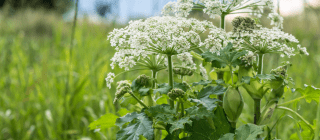
Vermont is home to some dangerous plants, animals, and bugs. Find out what to be aware of and how to avoid them, to keep you and your family safe and healthy.
There are plenty of things in the natural world that are potentially harmful to humans. Contact with certain insects, plants, and animals can make you very sick or even be fatal. Thankfully, we don’t have scorpions or fire ants here in Vermont. But we do have many other species to be wary of, including the world’s deadliest animal — the mosquito — which carries many diseases.
In this article, we’ll discuss dangerous plants, bugs, and animals living in Vermont that you should be aware of. We’ll also give you some advice on how to effectively repel or avoid them, so that you and your family can stay safe and healthy.
Insects
Ask Vermonters who spend time in the great outdoors what the most-pesky insect is, and they’ll probably say ticks. As our winters have become milder, the tick population has greatly increased. It is now very common to encounter ticks when outside in tall grass, brush, and forests. While Lyme disease is a well-known tick-borne illness in Vermont, tick bites can also transmit many other diseases. Cases of anaplasmosis and babesiosis, caused by bacteria and parasites carried by ticks, have increased in Vermont during the last 10 years.
A good way prevent tick bites is to wear long pants, long-sleeved shirts, socks, and other clothing items that have been treated with permethrin. Products that contain this insect repellant are widely available online and from local retailers that sell outdoor gear. Spray permethrin on the outside of clothing and let it dry before wearing. If permethrin is not available, use a spray with a high concentration of DEET on clothing before venturing out.
To keep ticks from getting inside your clothing, be sure to tuck your pant legs into your socks. Also tuck your shirt into your pants. Wearing light-colored clothing is helpful as it makes it easier to spot any ticks crawling on you. Check your clothing frequently and brush off any ticks you find. For more tips, check out our blog article on preventing tick bites.
Other potentially harmful insects include:
- Mosquitos — They may seem more like a nuisance than a health hazard, but mosquitos often carry many serious illnesses. In fact, mosquitos have been named the world’s deadliest animal, responsible for more than a million deaths every year. In Vermont, mosquitos are carriers of West Nile virus and Eastern equine encephalitis. To prevent mosquito bites, wear long-sleeved shirts and pants when outside. Spray exposed skin with an insect repellant containing DEET or another ingredient that’s proven to be effective against mosquitos. Also consider limiting your time outside at dawn or dusk, when mosquitos are most active. Reduce mosquito populations by getting rid of standing water on your property where mosquitos can breed.
- Wasps — These are aggressive insects that live in large colonies. Wasps are also known as yellowjackets or ground hornets. Their stings are not only painful, they can cause severe swelling and allergic reactions. The best way to prevent wasp stings is to avoid disturbing their nests, which can be difficult to locate if they are hidden in the ground. Keep watch for wasps flying in and out of areas, such as flower beds, and mark the location of any suspected nests as a reminder to stay away. Wasps will die as the weather gets colder, so you can wait them out. If that’s not possible, call a professional exterminator, as trying to eliminate a nest on your own can be very hazardous.
- Spiders — Most of the spiders found in Vermont are benign and beneficial, in that they eat other insects. There are a couple to avoid, if you do see them. The black widow spider has a shiny black body with a red hourglass shape on its abdomen. The brown recluse spider has a brown body with a violin-shaped marking on its back. While these venomous spiders are not common in our state, they occasionally show up here. The venomous Joro spider, which is not native to the U.S., has been moving up the East Coast, although none have been spotted in Vermont yet. To prevent spider bites, be careful when entering areas where spiders may be located, such as sheds and barns. Avoid disturbing their webs and wear protective clothing such as gloves, pants tucked into socks, and long-sleeved shirts. Before putting on clothing that has been left outside, such as boots, check for spiders first.
Plants
Tall yellow flowers that look like Queen Anne’s Lace are a common sight in Vermont, but these are plants that you’ll definitely want to stay away from.
Wild parsnip, also known as poison parsnip, produces a sap that burns the skin when it’s exposed to sunlight. It can produce painful rashes and blisters. To prevent this from happening, learn to identify wild parsnip and avoid contact with it. The plant is usually found growing along roadsides and in unmaintained fields.
If you have to enter areas where wild parsnip is growing, wear long pants, long-sleeved shirts, and gloves. Be sure to wash any clothes that may have touched the plant. If you get the sap on your skin, wash it off immediately with soap and water, and then protect your skin from being exposed to sunlight for at least 48 hours. If you have a reaction, call your health care provider.
Other potentially harmful plants include:
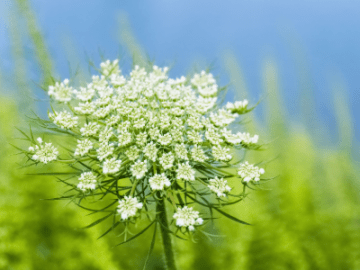
- Queen Anne’s Lace — Fields full of Queen Anne’s Lace, with its broad white flowers, can be quite beautiful. However, skin contact can cause irritation for some people. Avoid touching the plant and wear protective clothing when you need to be around it.
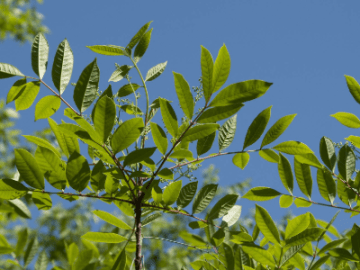
- Poison sumac — This is a woody shrub that likes to grow in swamps and other wet areas. It releases an oil when the plant is bruised or damaged that causes an allergic skin reaction. Poison sumac can cause allergic reactions even worse than poison ivy, and symptoms can last for weeks. To prevent reactions, learn to identify poison sumac so that you can avoid it. Wear protective clothing if you need to handle the plant, and immediately wash any oil off your skin with soap and cool water (don’t use warm water, as it causes the oil to spread). Rinse with rubbing alcohol. Clean under your fingernails to keep the oil from being spread to other parts of your body.
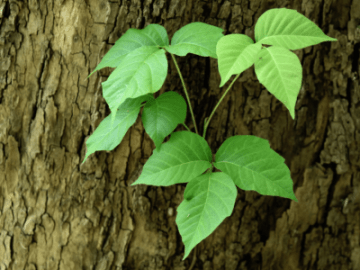
- Poison ivy — Like poison sumac, poison ivy produces an oily resin that causes an allergic reaction in some people. The entire plant contains this resin. Poison ivy can easily be identified by its leaves that grow in clusters of three. Remember the adage “leaves of three, let it be.” Poison ivy can grow at ground level, but it is also capable of climbing up trees and other plants. Keep an eye out for it and control it in areas that you or your pets frequent (pets can get the oil on them and spread it to you). Kill poison ivy by spraying it with herbicides or repeatedly cutting it to ground level. Be sure to wear protective clothing when you are around poison ivy and wash the clothing separately from other laundry. Consider using disposable gloves and discard them afterwards so that the resin is not spread. Don’t burn poison ivy because inhaling the smoke can cause a reaction.
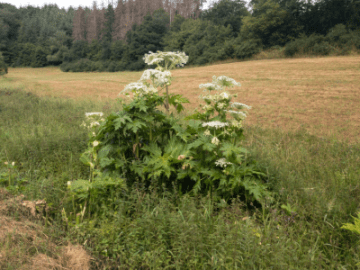
- Giant hogweed — As its name implies, giant hogweed is a huge plant that can grow up to 14 feet tall. Its leaves can be up to five feet wide. It has a white umbrella-shaped flower. Like wild parsnip, it produces a sap that can cause skin burns when combined with sunlight.
Animals
If you live in suburban or rural areas of Vermont, you’ve probably come across some of the critters on our list of potentially dangerous animals. Racoons, skunks, and bears are common sights as they search for food around homes.
While snakes are responsible for about 75,000 human deaths each year worldwide, poisonous snakes are not common in Vermont. The timber rattlesnake does reside in rock slides, ledges, and nearby woodlands here in Vermont. Known populations are in Rutland County. It is the only venomous snake found in the state, with a bite that has enough venom to possibly kill a human. However, timber rattlesnakes mostly eat small animals like mice, voles, and chipmunks, so biting humans is rare.
The timber rattlesnake is an endangered species in Vermont and is protected by law against killing, harming, and harassment, according to the Vermont Fish and Wildlife Department. If you see a rattlesnake on your property, don’t attempt to handle it. Instead, the state has a free service that will safely relocate rattlesnakes for you.
Other potentially harmful animals include:
- Racoons — These nocturnal animals are very adaptable and are found in a wide variety of locations, so chances of coming into contact with one are good, especially at night when they are out looking for food. They carry the rabies disease, so it is important to avoid them whenever possible. To prevent racoons from visiting your property, remove all potential food sources. Keep pet dishes and garbage cans inside buildings where racoons can’t get to them. Make sure that chicken coops are securely closed at night. Racoons will also dig for grubs in yards, so treating your lawn to kill grubs will help keep racoons away. If you see a racoon acting strangely and suspect it may be rabid, stay away and call your community’s animal control officer or a state game warden.
- Skunks — Like racoons, skunks will dig for grubs in yards and are most active at night. They can also carry rabies. Another danger for humans and pets is the skunk’s foul-smelling spray that can cause pain and temporary blindness. To prevent an unpleasant skunk encounter, remove food sources such as pet dishes and garbage cans from open areas around your home, and take steps to kill lawn grubs. Also, close garages and outbuildings where a skunk may wander in or be tempted to take up residence. Use heavy gauge screening to keep skunks from getting under porches or sheds. If you do come across a skunk, back away quietly and slowly to avoid startling the animal and being sprayed.
- Bears — The black bears that we have in Vermont are relatively shy and generally try to avoid humans. However, when they are hungry and food supplies in the forests are low, they will seek an easy meal by raiding bird feeders and garbage cans. They typically visit homes in the spring when they are scavenging for food. To keep bears away, secure trash cans inside a building. Always store pet food indoors, and only feed birds from December to March (when the bears are usually asleep). Put an electric fence around bee hives to protect them from bear attacks. If you encounter a bear in your backyard, don’t approach it. Instead, make loud noises such as shouting or banging on a pot to scare it away.
- Mice — Tiny mice might not seem like much of a threat to humans, but in Vermont the deer mouse and the white-footed mouse are carriers of hantavirus. Symptoms of hantavirus include fever, muscle aches, and fatigue. In later stages, people with the illness can develop a cough and shortness of breath. Hantavirus is found in mice urine, droppings, and saliva. Reduce mouse populations by sealing up holes in buildings to keep them from entering (a mouse can fit through a space only a quarter-inch wide). Put out mouse traps baited with peanut butter in places where mice travel, such as along the base of walls. Store food in containers that mice can’t get into. Eliminate potential nesting sites, such as folded tarps or piles of cloth. To prevent hantavirus infection, avoid stirring up mice droppings or nesting materials, so that you don’t breathe in droplets containing the virus.
More Information
We hope the tips in this article help you and your family stay healthy. If you would like more information, here are some additional sources to check out.
Zoonotic (animal-borne) diseases
Vermont critters
Mosquito-borne diseases
Poisonous plants in Vermont



